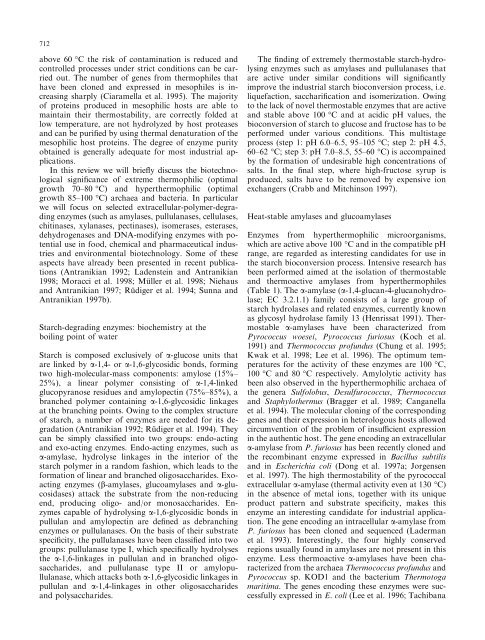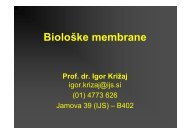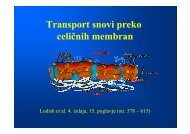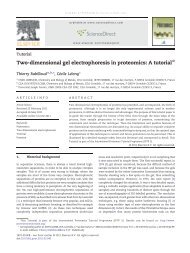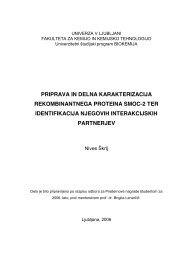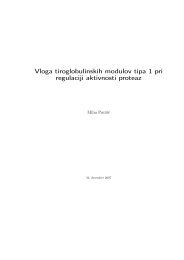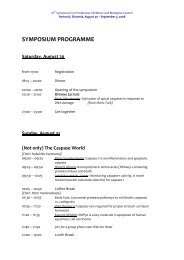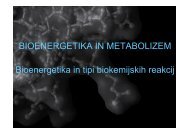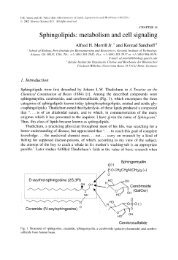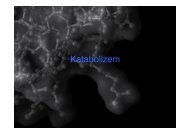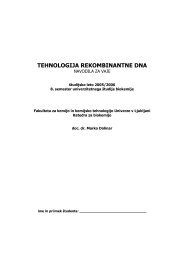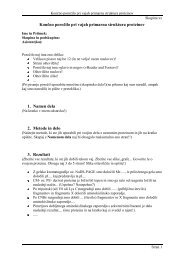Extremophiles as a source of novel enzymes for industrial application
Extremophiles as a source of novel enzymes for industrial application
Extremophiles as a source of novel enzymes for industrial application
Create successful ePaper yourself
Turn your PDF publications into a flip-book with our unique Google optimized e-Paper software.
712<br />
above 60 °C the risk <strong>of</strong> contamination is reduced and<br />
controlled processes under strict conditions can be carried<br />
out. The number <strong>of</strong> genes from thermophiles that<br />
have been cloned and expressed in mesophiles is incre<strong>as</strong>ing<br />
sharply (Ciaramella et al. 1995). The majority<br />
<strong>of</strong> proteins produced in mesophilic hosts are able to<br />
maintain their thermostability, are correctly folded at<br />
low temperature, are not hydrolyzed by host prote<strong>as</strong>es<br />
and can be puri®ed by using thermal denaturation <strong>of</strong> the<br />
mesophilic host proteins. The degree <strong>of</strong> enzyme purity<br />
obtained is generally adequate <strong>for</strong> most <strong>industrial</strong> <strong>application</strong>s.<br />
In this review we will brie¯y discuss the biotechnological<br />
signi®cance <strong>of</strong> extreme thermophilic (optimal<br />
growth 70±80 °C) and hyperthermophilic (optimal<br />
growth 85±100 °C) archaea and bacteria. In particular<br />
we will focus on selected extracellular-polymer-degrading<br />
<strong>enzymes</strong> (such <strong>as</strong> amyl<strong>as</strong>es, pullulan<strong>as</strong>es, cellul<strong>as</strong>es,<br />
chitin<strong>as</strong>es, xylan<strong>as</strong>es, pectin<strong>as</strong>es), isomer<strong>as</strong>es, ester<strong>as</strong>es,<br />
dehydrogen<strong>as</strong>es and DNA-modifying <strong>enzymes</strong> with potential<br />
use in food, chemical and pharmaceutical industries<br />
and environmental biotechnology. Some <strong>of</strong> these<br />
<strong>as</strong>pects have already been presented in recent publications<br />
(Antranikian 1992; Ladenstein and Antranikian<br />
1998; Moracci et al. 1998; MuÈ ller et al. 1998; Niehaus<br />
and Antranikian 1997; RuÈ diger et al. 1994; Sunna and<br />
Antranikian 1997b).<br />
Starch-degrading <strong>enzymes</strong>: biochemistry at the<br />
boiling point <strong>of</strong> water<br />
Starch is composed exclusively <strong>of</strong> a-glucose units that<br />
are linked by a-1,4- or a-1,6-glycosidic bonds, <strong>for</strong>ming<br />
two high-molecular-m<strong>as</strong>s components: amylose (15%±<br />
25%), a linear polymer consisting <strong>of</strong> a-1,4-linked<br />
glucopyranose residues and amylopectin (75%±85%), a<br />
branched polymer containing a-1,6-glycosidic linkages<br />
at the branching points. Owing to the complex structure<br />
<strong>of</strong> starch, a number <strong>of</strong> <strong>enzymes</strong> are needed <strong>for</strong> its degradation<br />
(Antranikian 1992; RuÈ diger et al. 1994). They<br />
can be simply cl<strong>as</strong>si®ed into two groups: endo-acting<br />
and exo-acting <strong>enzymes</strong>. Endo-acting <strong>enzymes</strong>, such <strong>as</strong><br />
a-amyl<strong>as</strong>e, hydrolyse linkages in the interior <strong>of</strong> the<br />
starch polymer in a random f<strong>as</strong>hion, which leads to the<br />
<strong>for</strong>mation <strong>of</strong> linear and branched oligosaccharides. Exoacting<br />
<strong>enzymes</strong> (b-amyl<strong>as</strong>es, glucoamyl<strong>as</strong>es and a-glucosid<strong>as</strong>es)<br />
attack the substrate from the non-reducing<br />
end, producing oligo- and/or monosaccharides. Enzymes<br />
capable <strong>of</strong> hydrolysing a-1,6-glycosidic bonds in<br />
pullulan and amylopectin are de®ned <strong>as</strong> debranching<br />
<strong>enzymes</strong> or pullulan<strong>as</strong>es. On the b<strong>as</strong>is <strong>of</strong> their substrate<br />
speci®city, the pullulan<strong>as</strong>es have been cl<strong>as</strong>si®ed into two<br />
groups: pullulan<strong>as</strong>e type I, which speci®cally hydrolyses<br />
the a-1,6-linkages in pullulan and in branched oligosaccharides,<br />
and pullulan<strong>as</strong>e type II or amylopullulan<strong>as</strong>e,<br />
which attacks both a-1,6-glycosidic linkages in<br />
pullulan and a-1,4-linkages in other oligosaccharides<br />
and polysaccharides.<br />
The ®nding <strong>of</strong> extremely thermostable starch-hydrolysing<br />
<strong>enzymes</strong> such <strong>as</strong> amyl<strong>as</strong>es and pullulan<strong>as</strong>es that<br />
are active under similar conditions will signi®cantly<br />
improve the <strong>industrial</strong> starch bioconversion process, i.e.<br />
liquefaction, sacchari®cation and isomerization. Owing<br />
to the lack <strong>of</strong> <strong>novel</strong> thermostable <strong>enzymes</strong> that are active<br />
and stable above 100 °C and at acidic pH values, the<br />
bioconversion <strong>of</strong> starch to glucose and fructose h<strong>as</strong> to be<br />
per<strong>for</strong>med under various conditions. This multistage<br />
process (step 1: pH 6.0±6.5, 95±105 °C; step 2: pH 4.5,<br />
60±62 °C; step 3: pH 7.0±8.5, 55±60 °C) is accompained<br />
by the <strong>for</strong>mation <strong>of</strong> undesirable high concentrations <strong>of</strong><br />
salts. In the ®nal step, where high-fructose syrup is<br />
produced, salts have to be removed by expensive ion<br />
exchangers (Crabb and Mitchinson 1997).<br />
Heat-stable amyl<strong>as</strong>es and glucoamyl<strong>as</strong>es<br />
Enzymes from hyperthermophilic microorganisms,<br />
which are active above 100 °C and in the compatible pH<br />
range, are regarded <strong>as</strong> interesting candidates <strong>for</strong> use in<br />
the starch bioconversion process. Intensive research h<strong>as</strong><br />
been per<strong>for</strong>med aimed at the isolation <strong>of</strong> thermostable<br />
and thermoactive amyl<strong>as</strong>es from hyperthermophiles<br />
(Table 1). The a-amyl<strong>as</strong>e (a-1,4-glucan-4-glucanohydrol<strong>as</strong>e;<br />
EC 3.2.1.1) family consists <strong>of</strong> a large group <strong>of</strong><br />
starch hydrol<strong>as</strong>es and related <strong>enzymes</strong>, currently known<br />
<strong>as</strong> glycosyl hydrol<strong>as</strong>e family 13 (Henrissat 1991). Thermostable<br />
a-amyl<strong>as</strong>es have been characterized from<br />
Pyrococcus woesei, Pyrococcus furiosus (Koch et al.<br />
1991) and Thermococcus pr<strong>of</strong>undus (Chung et al. 1995;<br />
Kwak et al. 1998; Lee et al. 1996). The optimum temperatures<br />
<strong>for</strong> the activity <strong>of</strong> these <strong>enzymes</strong> are 100 °C,<br />
100 °C and 80 °C respectively. Amylolytic activity h<strong>as</strong><br />
been also observed in the hyperthermophilic archaea <strong>of</strong><br />
the genera Sulfolobus, Desulfurococcus, Thermococcus<br />
and Staphylothermus (Bragger et al. 1989; Canganella<br />
et al. 1994). The molecular cloning <strong>of</strong> the corresponding<br />
genes and their expression in heterologous hosts allowed<br />
circumvention <strong>of</strong> the problem <strong>of</strong> insu cient expression<br />
in the authentic host. The gene encoding an extracellular<br />
a-amyl<strong>as</strong>e from P. furiosus h<strong>as</strong> been recently cloned and<br />
the recombinant enzyme expressed in Bacillus subtilis<br />
and in Escherichia coli (Dong et al. 1997a; Jorgensen<br />
et al. 1997). The high thermostability <strong>of</strong> the pyrococcal<br />
extracellular a-amyl<strong>as</strong>e (thermal activity even at 130 °C)<br />
in the absence <strong>of</strong> metal ions, together with its unique<br />
product pattern and substrate speci®city, makes this<br />
enzyme an interesting candidate <strong>for</strong> <strong>industrial</strong> <strong>application</strong>.<br />
The gene encoding an intracellular a-amyl<strong>as</strong>e from<br />
P. furiosus h<strong>as</strong> been cloned and sequenced (Laderman<br />
et al. 1993). Interestingly, the four highly conserved<br />
regions usually found in amyl<strong>as</strong>es are not present in this<br />
enzyme. Less thermoactive a-amyl<strong>as</strong>es have been characterized<br />
from the archaea Thermococcus pr<strong>of</strong>undus and<br />
Pyrococcus sp. KOD1 and the bacterium Thermotoga<br />
maritima. The genes encoding these <strong>enzymes</strong> were successfully<br />
expressed in E. coli (Lee et al. 1996; Tachibana


